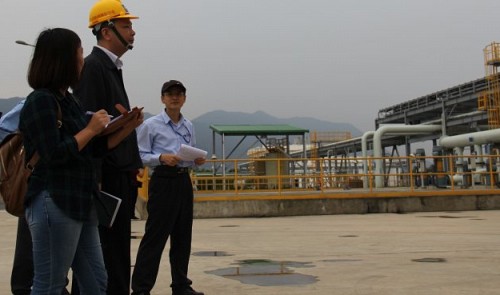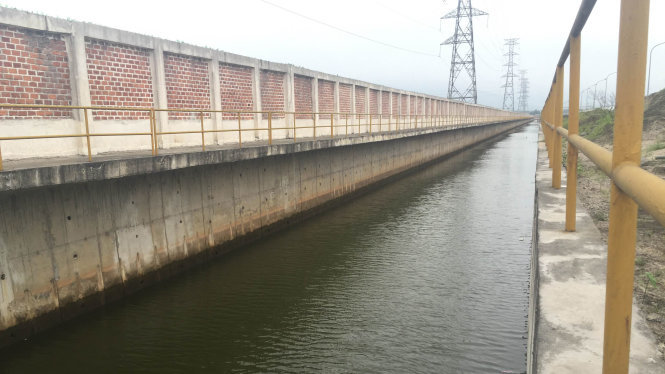Vietnam to ask Formosa to change technology in wake of fish death scandal
 |
| People are pictured near the wastewater treatment area at the Formosa steel plant in Ha Tinh, located in north-central Vietnam. |
Vietnam will closely oversee the technology change at the Formosa steel mill in the north-central province of Ha Tinh, which is also part of a five-point commitment the Taiwanese firm has made after its role in the environmental disaster was revealed last week.
“Under our supervision, Formosa will have to change some types of technology at their steel mill, in line with what their leaders had promised,” Deputy Minister of Science and Technology Pham Cong Tac said at a ministry press briefing in Hanoi.
The Vietnamese government announced on June 30 the results of a two-month inspection into the mass fish deaths observed between April and May along the coast of Ha Tinh and three other provinces, Quang Binh, Quang Tri and Thua Thien-Hue.
The investigation, with more than 100 scientists involved, found that untreated wastewater from the Ha Tinh steel plant of Formosa, containing such toxic substances as phenol, cyanide and ferric hydroxide, had been dumped into the ocean, leading to the fish deaths.
The Taiwanese admitted its wrongdoing and made five commitments, including apologizing to Vietnam, paying US$500 million in damages, and improving its steelmaking technology.
 |
| Deputy Minister of Science and Technology Pham Cong Tac |
Scientists have found that the direct cause of the fish deaths was wastewater resulting from a technology known as wet-quenching coke, in which the coke is sprayed with water for cooling, resulting in high CO2 emissions and thermal energy loss.
In steelmaking, coke is used as a fuel and as a reducing agent in smelting iron ore in a blast furnace.
The Formosa plant in Vietnam currently deploys these pieces of technology.
It is suggested that Formosa switch to the dry-quenching coke method, in which coke is cooled using an inert gas, to avoid repeating its mistake.
Passing the buck
Formosa had initially intended to apply the dry cooling technology, but eventually adapted the wet-quenching method to save costs.
This leads to the question as to which Vietnamese bodies are responsible for allowing the use of the polluting technology at the steel plant in Ha Tinh.
The answer from the science ministry, giving by a top official at the same meeting in Hanoi, was “it wasn’t me.”
Do Hoai Nam, head of the technology evaluation and assessment agency within the science ministry, told reporters that the ‘role allocation’ in the case of the Formosa project is clear.
The science ministry only had a role in the prefeasibility study, whereas the Ha Tinh administration was responsible for issuing the investment approval and the Ministry of Industry and Trade was accountable for backing the technology plan of the Taiwanese developer, Nam elaborated.
Nam said when the Ha Tinh administration sought advice from the science ministry on the technology plan of the Formosa steel mill, the response was that the blast furnace technology the Taiwanese proposed using is “common, but not modern, in the world.”
“As the project was at that time in the prefeasibility stage, we could not say anything more specific,” Nam explained.
 |
| The wastewater discharge canal at the Formosa steel plant |
The official then confirmed that it was the industry ministry that eventually approved the technology plan for Formosa.
“We were not directly involved in the technology evaluation and assessment for [this] project,” he underlined.
Interestingly enough, the industry ministry also ducked responsibility for the incident as alleged by its technology counterpart.
Asked about the statement Nam made at the press meeting, Minister of Industry and Trade Tran Tuan Anh asserted that his ministry never assessed the wet-quenching coke technology or allowed Formosa to use it.
“It is not among the designated functions of the Ministry of Industry and Trade to do so,” he said. “Our ministry is not a [technology] evaluation agency.”
What the stars mean:
★ Poor ★ ★ Promising ★★★ Good ★★★★ Very good ★★★★★ Exceptional
Latest News
More News
- Ericsson a trusted partner in the digital economy (December 03, 2025 | 10:33)
- 5G and AI to shape next phase of digital economy (December 03, 2025 | 10:25)
- Fly to Con Dao from 0 VND with Vietjet mega promotion (December 02, 2025 | 16:50)
- Tien Phong strives for a greener plastics industry (December 02, 2025 | 09:22)
- Czech enterprises strengthen presence (December 01, 2025 | 18:00)
- New phase launched to support women-led ventures (December 01, 2025 | 15:08)
- Airlines race to patch Airbus A320/A321 fleets (December 01, 2025 | 09:17)
- European expertise to boost Vietnam’s sustainable logistics push (November 29, 2025 | 10:00)
- AkzoNobel: from painting walls to painting the future (November 28, 2025 | 13:31)
- Tien Phong Plastic ready for a new growth cycle (November 28, 2025 | 10:56)

 Tag:
Tag:















 Mobile Version
Mobile Version